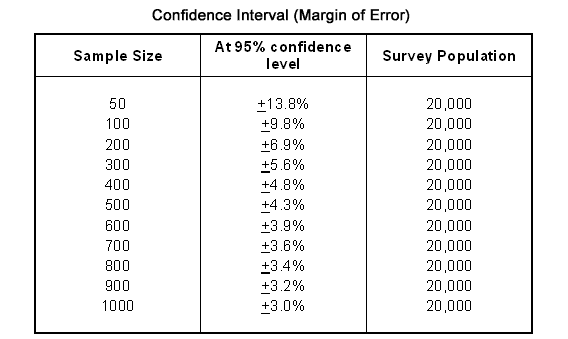Full–service market research firm with proprietary panels
B2B Research • Consumer Surveys • IT Research • Low Incidence Studies
Market Research Resources
Amplitude Research is pleased to provide the following information as a helpful resource for survey researchers and others:
Glossary of Market Research Terms - Complete Directory for Market Research Terms from A to Z.
Sample Market Research Questions - Sample Survey Questions related to Geography, Household Income, Education Level, etc.
Sample Questionnaire Templates - Questionnaire Samples for Customer Satisfaction Surveys, Market Research Surveys and more.
Sample Size Calculator
Amplitude Research has provided this Sample Size Calculator as a public service. For ease of use, we have assumed: (A) a 95% confidence level, which is typically (but not always) used by market research firms, (B) a sampling error at its most conservative response distribution of 50%, and (C) a survey population assumption of 20,000 (number of people in the group you are studying).
This calculator is designed for market research estimates where the survey population is in the nature of a nationwide, regional, or metropolitan area survey population, or in other consumer studies or b2b research where the targeted survey population is 20,000 or more. Larger survey populations may result in slightly higher margins of error, although the differences would be insignificant in most cases. Population size is likely to be an important factor when the survey population is relatively small and a known group of people. In fact, our market research firm could have selected a population size less than 20,000, but used 20,000 as the cut-off given the very small changes in margin of error as the population increases above this number. For example, a sample size of 600 out of a survey population of 20,000 results in a 3.9 confidence interval, while a survey population of 100,000 results in a 4.0 confidence interval, and a survey population of 1,000,0000 also results in a 4.0 confidence interval.
Please trace across each row based on the Sample Size (number of completes) to determine the Confidence Interval (margin of error) in the confidence level column.

About Sampling Error
Market research firms are often asked about the meaning of "sampling error". For those not familiar with sampling error / statistical theory, the margin of sampling error can be thought of roughly as a gauge of how much the survey results could potentially differ from what would be obtained if every possible person who could qualify for a study was surveyed.
Because study results are based on a sample, it is helpful to keep in mind that a "margin of sampling error" is associated with each percentage from the survey. "Sampling error" decreases as the number of surveys completed increases. At the same time, for a given sample size, sampling error is highest for percentages from the survey near 50% and decreases as percentages get further from 50% (e.g., 10% or 90%).
For example, for a random sample of 400 survey respondents among a nationwide population, the sampling margin of error is plus or minus (+/-) 4.9 percentage points for percentages from the survey near 50% and +/- 2.9 percentage points for percentages from the survey near 10% or 90%.
For those interested in slightly more technical detail, a sampling margin of error must have a "confidence level" associated with it. The "95% confidence level" is what is typically used by market research firms (or assumed if a confidence level is not formally stated). A sampling margin of error at the "95% confidence level" can be interpreted roughly as providing a 95% probability that the percentage from the survey plus or minus (+/-) the margin of error contains the "true" value. (The "true" value would be known only if the market research firm surveyed everyone in the target market rather than just a sample.)
In addition to sampling error, results obtained by market research firms may be subject to various sources of non-sampling error (e.g., non-response bias, respondent misinterpretation of question wording, unique aspects of different research modes – telephone vs. mail vs. web, etc.). The degree of non-sampling error is not represented by the sampling margin of error and is usually unknown.
Other Interesting Market Research Resources
The following are links to market research resources of statistical and general market research information:
Market Research Analysts - published by the U.S. Department of Labor, Occupational Outlook Handbook, 2012-13 Edition. Provides detailed information on the occupational outlook for persons working as market and survey researchers.
Conducting Market Research? Here are 5 Official Sources of Free Data That Can Help - published by SBA.gov, U.S. Small Business Administration. Includes links to "five government sources of market data and statistics that may boost your market research efforts".
Thinking About Starting a Business? - published by SBA.gov, U.S. Small Business Administration. Article about understanding your market.
Online Market Research Surveys - - Survey Length
- published by Amplitude Research. Article about questionnaire design and survey length.
Online Market Research Surveys - - Maximizing Your ROI - published by Amplitude Research. Article about survey costs and maximizing your return on investment.
Please contact us if you would like to learn more about why we are one of the top market research firms.
- LEARN MORE ABOUT OUR MARKET RESEARCH FIRM.
Questions? Call Us at 1-877-225-7950
